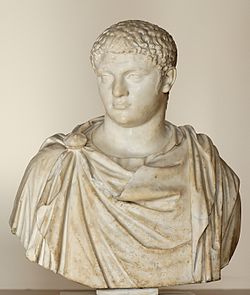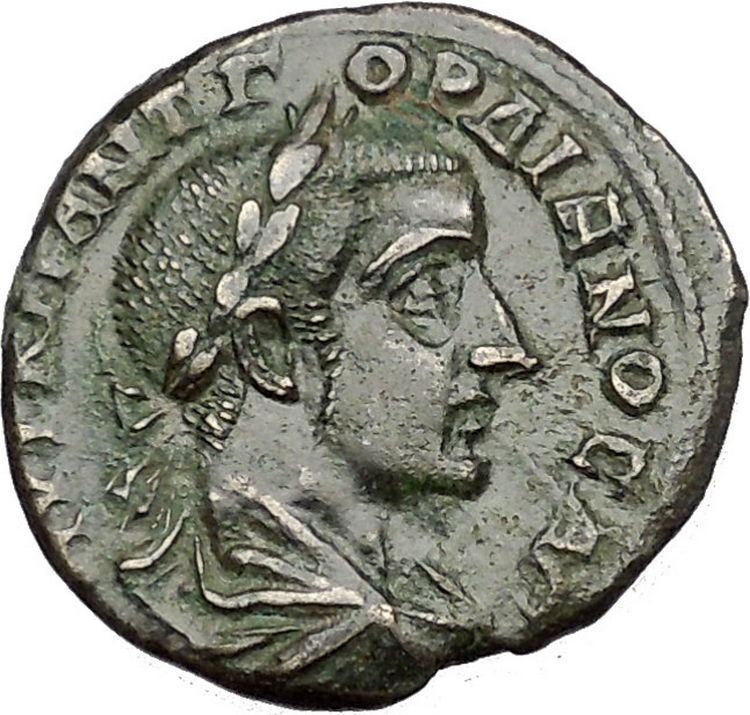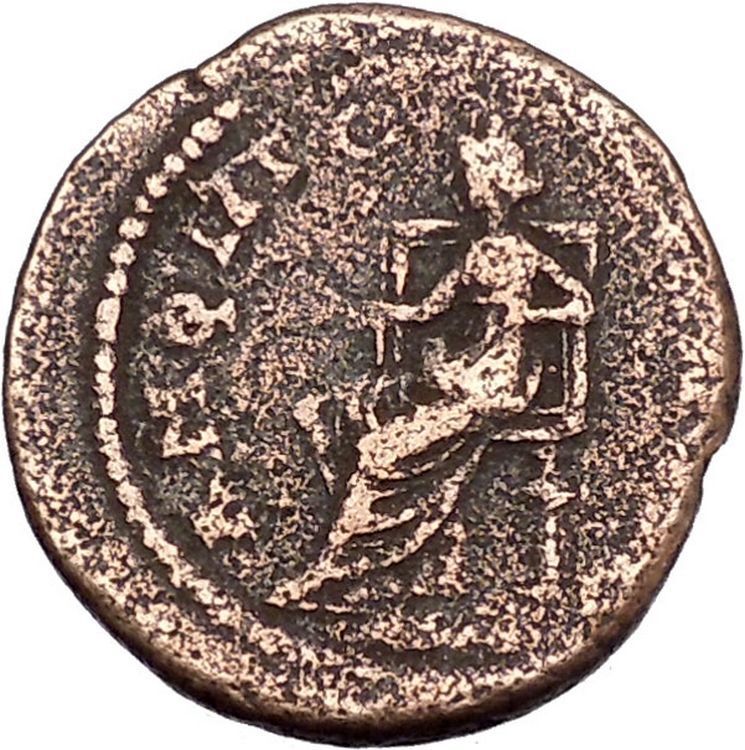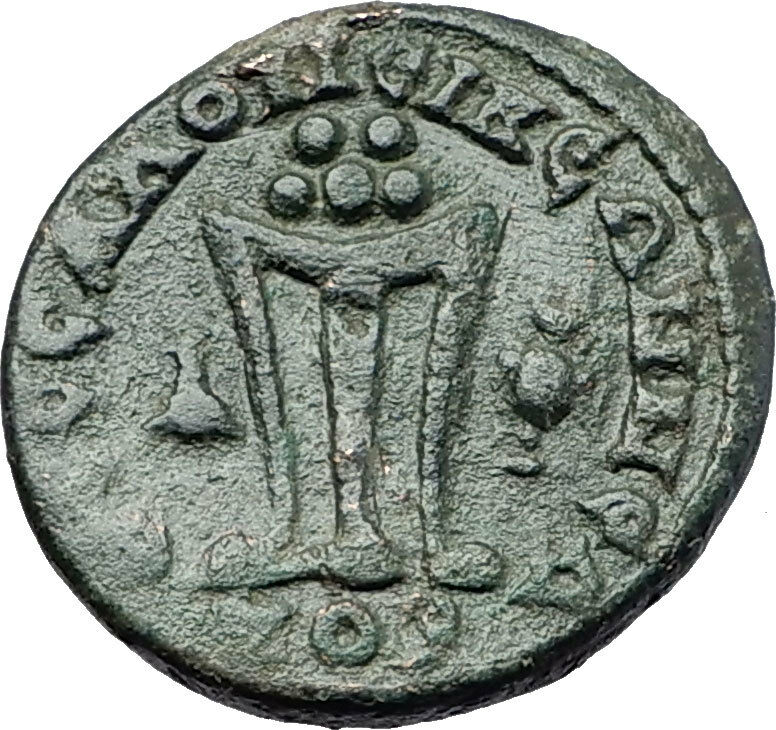|
Geta
– Roman Caesar: 198-209 A.D. –
Roman Emperor
: 209-211 A.D. –
Bronze 15mm (1.91 grams) of
Nicaea
in
Bithynia
ΓΕΤΑC ΚΑΙCAΡ, bare head of Geta right.
ΝΙΚΑΙΕΩΝ, Agonistic Olympic-type athletic games prize
urn
with a palm branch within.
You are bidding on the exact item pictured,
provided with a Certificate of Authenticity and Lifetime Guarantee of
Authenticity.
Nicaea was a Hellenic city in northwestern
Anatolia
, and is primarily known as the site of
the
First
and
Second
Councils of Nicaea (the first and
seventh
Ecumenical councils
in the early history of the
Christian Church
), the
Nicene Creed
(which comes from the First
Council), and as the capital city of the
Empire of Nicaea
. Nicaea served as the interim
capital city of the
Byzantine Empire
between 1204 and 1261,
following the
Fourth Crusade
in 1204, until the recapture of
Constantinople
by the Byzantines in 1261.
The ancient city is located within modern
Iznik
,
Turkey
, and is situated in a fertile basin at
the eastern end of
Lake Ascanius
, bounded by ranges of hills to
the north and south. It is situated with its west wall rising from the lake
itself, providing both protection from siege from that direction, as well as a
source of supplies which would be difficult to cut off. The lake is large enough
that it could not be blockaded from the land easily, and the city was large
enough to make any attempt to reach the harbour from shore-based siege weapons
very difficult.
The ancient city is surrounded on all sides by 5 km (3 mi) of walls about
10 m (33 ft) high. These are in turn surrounded by a double ditch on the land
portions, and also included over 100 towers in various locations. Large gates on
the three landbound sides of the walls provided the only entrance to the city.
Today the walls have been pierced in many places for roads, but much of the
early work survives and, as a result, it is a major tourist destination.
History
Early history, Roman and Byzantine Empires

The Lefke Gate, part of Nicaea’s city walls.
The place is said to have been colonized by
Bottiaeans
, and to have originally borne the
name of Ancore (Steph.
B. s. v.) or Helicore (Geogr. Min. p. 40, ed. Hudson); but it
was subsequently destroyed by the
Mysians
. A few years after the death of
Alexander the Great
,
Macedonian
king
Antigonus
— who had taken control of much of
Asia Minor
upon the death of Alexander (under
whom Antigonus had served as a general) — probably after his victory over
Eumenes
, in 316 BC, rebuilt the town, and
called it, after himself, Antigoneia (Greek:
Αντιγόνεια). (Steph. B. l. c.; Eustath. ad
Horn. II. ii. 863)
Several other of Alexander’s generals (known together as the
Diadochi
(Latin “successors”)) later
conspired to remove Antigonus, and after defeating him the area was given to
Thessalian
general
Lysimachus
(Lysimakhos) (circa 355
BC-281 BC) in 301 BC as his share of the lands. He renamed it Nicaea
(Greek:
Νίκαια
, also
transliterated
as Nikaia or Nicæa;
see also
List of traditional Greek place names
), in
tribute to his wife
Nicaea
, a daughter of
Antipater
. (Steph. B., Eustath., Strab., ll.
cc.)
According to another account (Memnon, ap. Phot. Cod. 224. p. 233, ed. Bekker),
Nicaea was founded by men from
Nicaea
near
Thermopylae
, who had served in the army of
Alexander the Great. The town was built with great regularity, in the form of a
square, measuring 16 stadia in circumference; it had four gates, and all its
streets intersected one another at right angles, so that from a monument in the
centre all the four gates could be seen. (Strabo
xii. pp. 565 et seq.) This monument stood in the gymnasium, which was
destroyed by fire, but was restored with increased magnificence by the
younger Pliny
(Epist. x. 48), when he was
governor of Bithynia
.
The city was built on an important crossroads between
Galatia
and
Phrygia
, and thus saw steady trade. Soon after
the time of Lysimachus, Nicaea became a city of great importance, and the kings
of Bithynia, whose era begins in 288 BC with
Zipoetes
, often resided at Nicaea. It has
already been mentioned that in the time of Strabo it is called the metropolis of
Bithynia, an honour which is also assigned to it on some coins, though in later
times it was enjoyed by
Nicomedia
.
The two cities kept up a long and vehement dispute about the precedence, and
the 38th oration of
Dio Chrysostomus
was expressly composed to
settle the dispute. From this oration, it appears that Nicomedia alone had a
right to the title of metropolis, but both were the first cities of the country.

The theatre, restored by
Pliny
, but now fallen once again
into dilapidation.
The younger Pliny makes frequent mention of Nicaea and its public buildings,
which he undertook to restore when governor of Bithynia. (Epist. x. 40, 48,
etc.) It was the birthplace of the mathematician and astronomer
Sporus
(circa 240), the astronomer
Hipparchus
(circa 194 BC), and the historian
Dio Cassius
(circa 165). It was the death-place
of the comedian
Philistion
.
The numerous coins of Nicaea which still exist attest the interest taken in
the city by the emperors, as well as its attachment to the rulers; many of them
commemorate great festivals celebrated there in honour of gods and emperors, as
Olympia, Isthmia, Dionysia, Pythia, Commodia, Severia, Philadelphia, etc.
Throughout the imperial period, Nicaea remained an important town; for its
situation was particularly favourable, being only 40 km (25 mi) distant from
Prusa
(Pliny
v. 32), and 70 km (43 mi) from
Constantinople
. (It.
Ant. p. 141.) When Constantinople became the capital of the
Eastern Empire
, Nicaea did not lose in
importance; for its present walls, which were erected during the last period of
the Empire, enclose a much greater space than that ascribed to the place in the
time of Strabo. Much of the existing architecture and defensive works date to
this time, early 4th century.
Nicaea suffered much from earthquakes in 358, 362 and 368; after the last of
which, it was restored by the emperor
Valens
.
Nicaea in early
Christianity
The First Council of Nicaea (/naɪ’si:ə/;
Greek
: Νίκαια
/’ni:kaɪja/) was a council of Christian bishops convened in Nicaea in
Bithynia
(present-day
İznik
in
Turkey
) by the
Roman Emperor
Constantine I
in
AD
325. This first
ecumenical council
was the first effort to
attain
consensus
in the church through an
assembly
representing all of
Christendom
. The
doctrine
of the Trinity was finalized at the
Council of Constantinople in 381 AD which expressly included the Holy Ghost as
equal to the Father and the Son.
The first Nicene Council was probably held in what would become the now
ruined mosque of Orchan. The church of Hagia Sophia was built by
Justinian I
in the middle of the city in the
6th century (modelled after the larger
Hagia Sophia
in Constantinople), and it was
there that the
Second Council of Nicaea
met in 787 to discuss
the issues of
iconography
. The city was
assaulted
by the
Umayyads
in 727 but held firm.
Crusades
The city saw a long period of peace under Byzantine rule, which lasted until
the rise of the
Seljuk Turks
. In 1077 they took the city, which
changed hands several times in the next year until it was firmly in their
control by 1078. Here they formed their capital. This event was instrumental in
starting the
First Crusade
at Byzantium’s request in 1095,
resulting in armies from Europe along with smaller units from Byzantium
converging on the city in 1097. After the European armies
laid siege to the city
and penetrated the
walls, they were surprised to awake the next morning to see the Roman flags of
Emperor
Alexios I Komnenos
flying over the city. Robbed
of their chance to plunder the city, the crusaders and Byzantines were soon at
odds. In the peace which was afterwards concluded the city was ceded to the
Byzantines.
The 12th century saw a period of relative stability and prosperity at Nicaea.
The
Komnenian
emperors Alexios, John and Manuel
campaigned extensively to strengthen the Byzantine presence in Asia Minor. Major
fortifications were constructed across the region, especially by John and
Manuel, which helped to protect the city and its fertile hinterland. There were
also several military bases and colonies in the area, for example the one at
Rhyndakos
in Bithynia, where the emperor John
spent a year training his troops in preparation for campaigns in southern Asia
Minor.
Constantinople later fell in 1204 to the European armies in the
Fourth Crusade
, who set up the
Latin Empire
of Constantinople. They had poor
control over the area, and a number of Byzantine successor states sprang up as
well, including
Epirus
and
Trebizond
. It was Nicaea that formed the core
of the successor Byzantine Empire after
Theodore Laskaris
(who became Theodore I)
founded the
Empire of Nicaea
(western Asia Minor) there.
Building on the strong military infrastructure built up in the area over the
last century, Theodore I and his successors slowly expanded their domains, and
in 1259
Michael VIII Palaeologus
usurped the throne. He
captured Constantinople from the Latins in 1261, and restored the Byzantine
Empire.
Ottoman Empire
In 1331, the city was conquered and incorporated into the
Ottoman Empire
by
Orhan I
. Many of its public buildings were
destroyed, and the materials were used by the
Ottomans
in erecting their mosques and other
edifices. With the
fall of Constantinople
in 1453, the town lost a
great degree of its importance, but later became a major center with the
creation of a local faïence
pottery
-making industry in the 17th century.
Ruins
The ancient walls, with their towers and gates, are relatively well
preserved. Their circumference is 3,100 m (10,171 ft), being at the base from 5
to 7 m (16 to 23 ft) in thickness, and from 10 to 13 m (33 to 43 ft) in height;
they contain four large and two small gates. In most places they are formed of
alternate courses of Roman tiles and large square stones, joined by a cement of
great thickness. In some places columns and other architectural fragments from
the ruins of more ancient edifices have been inserted. As with those of
Constantinople, the walls seem to have been built in the 4th century. Some of
the towers have
Greek
inscriptions.[2]
The ruins of mosques, baths, and houses, dispersed among the gardens and
apartment buildings that now occupy a great part of the space within the Roman
and Byzantine fortifications, show that the Ottoman era town center, though now
less considerable, was once a place of importance; but it never was as large as
the Byzantine city. It seems to have been almost entirely constructed of the
remains of the Byzantine era Nicaea, the walls of the ruined mosques and baths
being full of the fragments of ancient Greek, Roman and Byzantine temples and
churches. In the northwestern parts of the town, two moles extend into the lake
and form a harbour; but the lake in this part has much retreated, and left a
marshy plain. Outside the walls are the remnants of an ancient aqueduct.The
Church of the Dormition, the principal Greek Orthodox church in Nicaea, was one
of the most architecturaly important Byzantine churches in
Asia Minor
. A domed church with a cross-shaped
nave and elongated apse, and dating from the perhaps as early as the end of the
6th century, its bema was decorated with very fine mosaics that had been
restored in the 9th century. The Church of the Dormition was destroyed in 1922;
only the lower portions of some of its walls survive today.
Excavations are underway in the Ottoman kilns where the historic Nycean
tileware were made. The Hagia Sophia is also undergoing restoration.
Contemporary influence
Nicaea remains a
titular see
of the
Roman Catholic Church
, Nicaenus; the
seat has been vacant since the death of its last bishop in 1976.It is also a
titular
metropolitan
see of the
Ecumenical Patriarchate of Constantinople
. The
incumbent 2001–2010 was the former
Archbishop of Karelia and All Finland
,
Metropolitan
Johannes (Rinne)
.
Notable people
- Hipparchus
(2nd century BC) Greek
astronomer, geographer, and mathematician
-
Sporus of Nicaea
(b. ca. 240; d. ca. 300)
Greek mathematician and astronomer
-
Georgius Pachymeres
(1242 – c. 1310),
Byzantine historian
- Cassius Dio
(AD c.165–c.229), Roman
historian
Publius Septimius Geta (March
7, 189
–December
26, 211
), was a
Roman Emperor
co-ruling with his father
Septimius Severus
and his older brother
Caracalla
from 209 to his death.
Geta was the younger son of Septimius Severus by his second wife
Julia Domna
. Geta was born in
Rome, at a time when his father was only a provincial governor at the
service of emperor
Commodus
.
Geta was always in a place secondary to his older brother Lucius, the heir
known as Caracalla. Perhaps due to this, the relations between the two were
difficult from their early years. Conflicts were constant and often required the
mediation of their mother. To appease his youngest son, Septimius Severus gave
Geta the title of Augustus in 209. During the campaign against the
Britons of the early 3rd century, the imperial propaganda publicized a happy
family that shared the responsibilities of rule. Caracalla was his father’s
second in command, Julia Domna the trusted counsellor and Geta had
administrative and bureaucratic duties. Truth was that the rivalry and antipathy
between the brothers was far from being improved.
Joint Emperor
When Septimius Severus died in
Eboracum in the beginning of 211, Caracalla and Geta were proclaimed
joint emperors and returned to Rome.

Regardless, the shared throne was not a success: the brothers argued about
every decision, from law to political appointments. Later sources speculate
about the desire of the two of splitting the empire in two halves. By the end of
the year, the situation was unbearable. Caracalla tried to murder Geta during
the festival of
Saturnalia
without success. Later in December
he arranged a meeting with his brother in his mother’s apartments, and had him
murdered in her arms by
centurions
.
Following Geta’s assassination, Caracalla
damned his memoryy
and ordered his name to be
removed from all inscriptions. The now sole emperor also took the opportunity to
get rid of his political enemies, on the grounds of conspiracy with the
deceased. Cassius Dio
stated that around 20,000 persons
of both sexes were killed and/or proscribed during this time.
|












